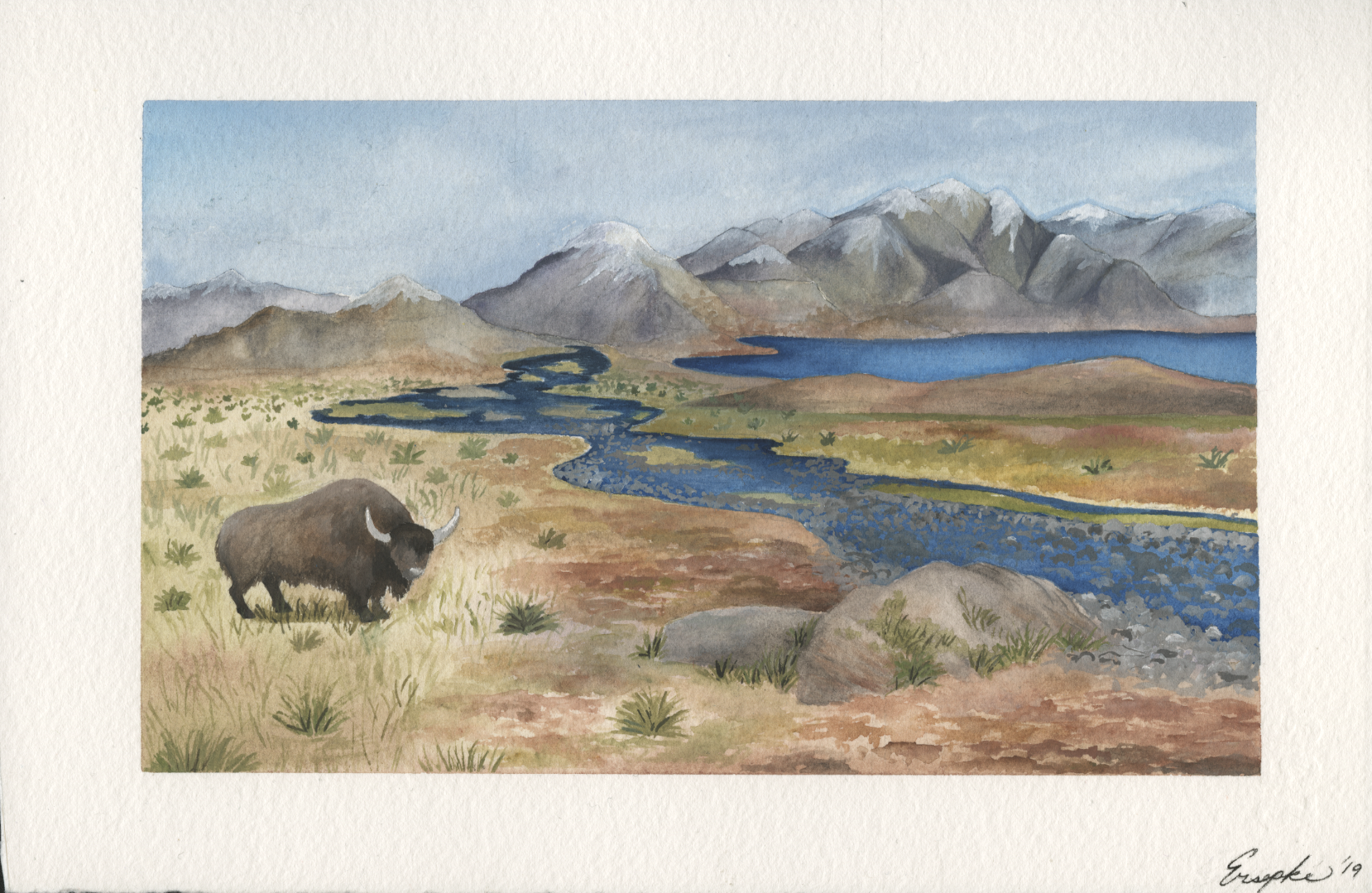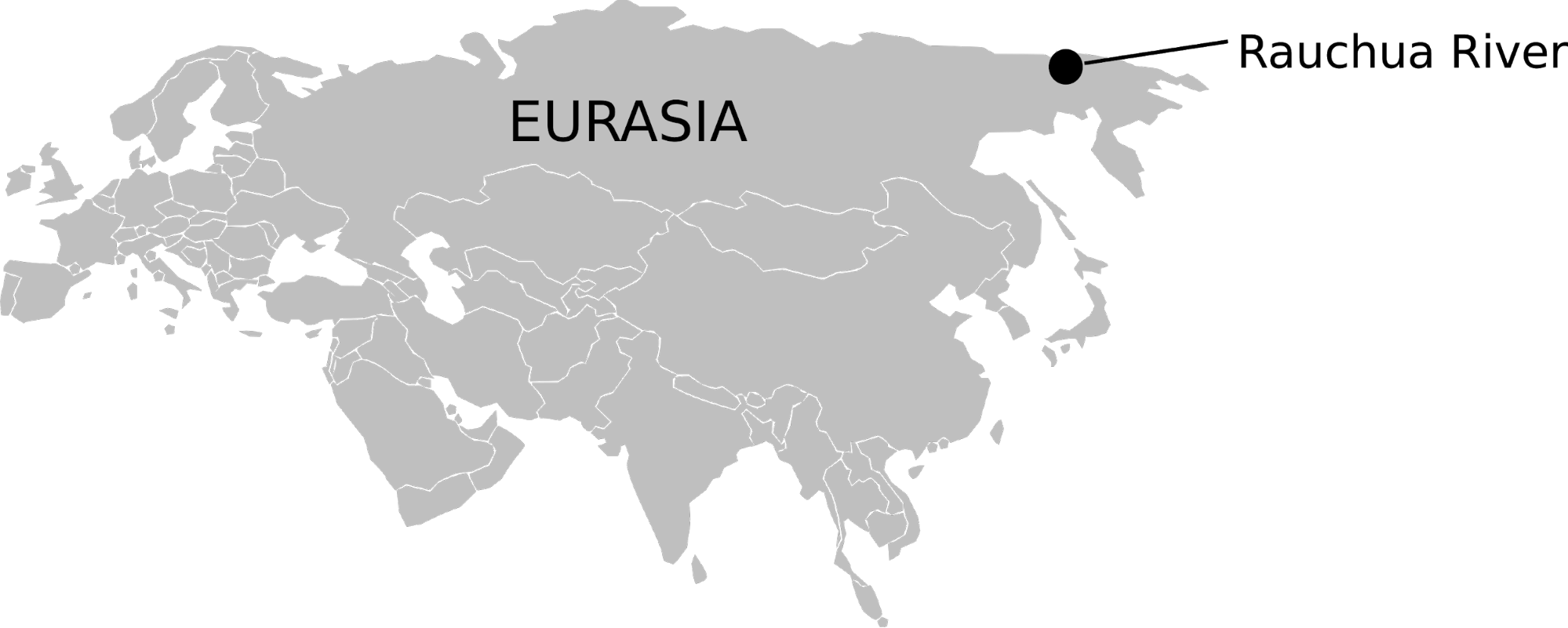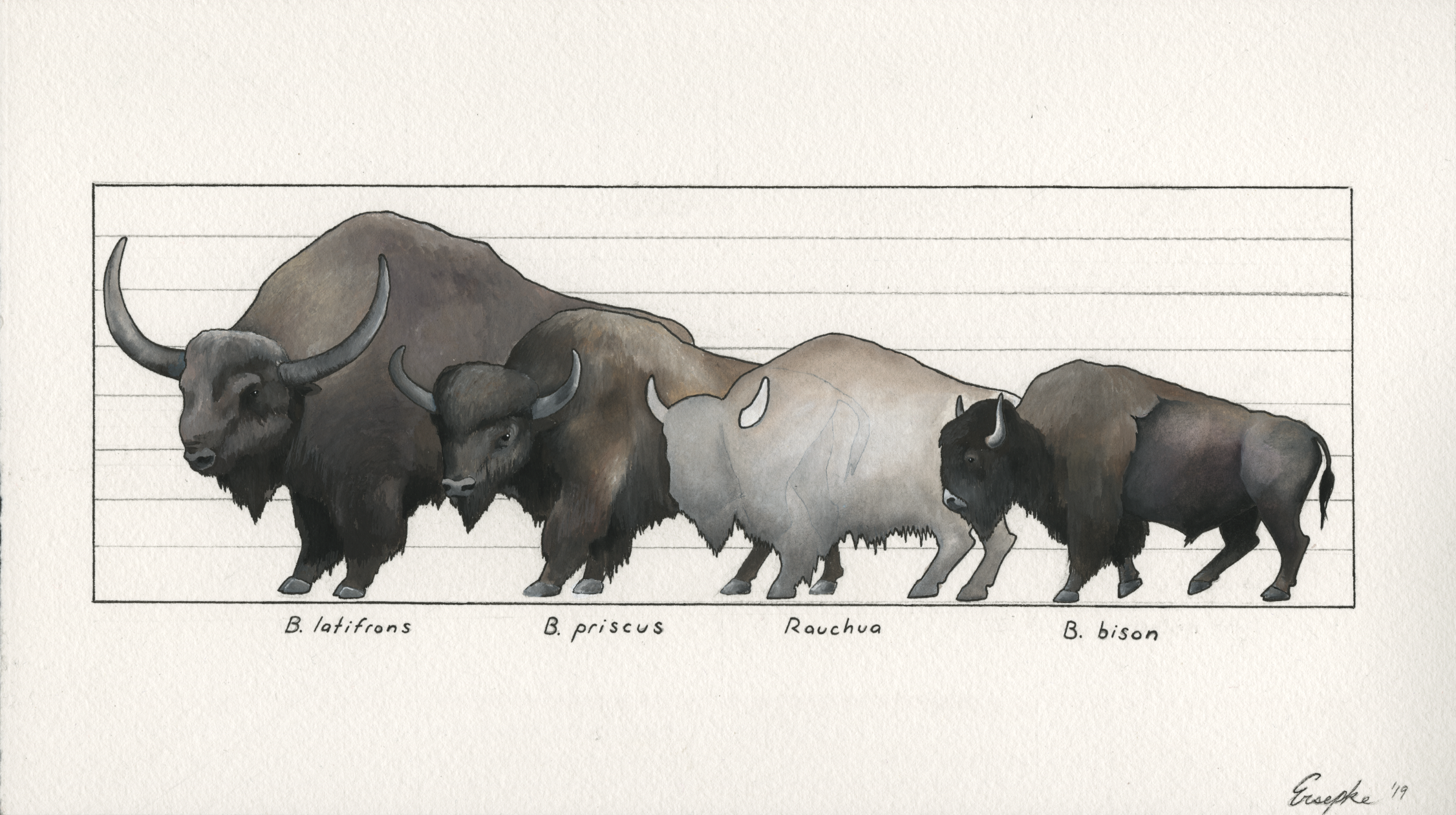What can the frozen carcass of a 9,500 year old bison tell us about evolution? More than you think!
 Thanks to many frozen bison carcasses, over the last decade, we understand much about the taxonomy and migrations of Bison. We know, for example, that bison evolved more than a million years ago in Asia, and that they migrated across the Bering Land Bridge into North America only 160 thousand years ago (kya). We also know that bison went extinct across much of their former range within the last 2,000 years, with only two species present today: Bison bonasus, the european bison or wisent, and Bison bison, the North American bison or buffalo. Much uncertainty remains, however, about how much diversity there was in the genus Bison, about where the diversity existed, and about how all of that diversity disappeared after the end of the last ice age.
Thanks to many frozen bison carcasses, over the last decade, we understand much about the taxonomy and migrations of Bison. We know, for example, that bison evolved more than a million years ago in Asia, and that they migrated across the Bering Land Bridge into North America only 160 thousand years ago (kya). We also know that bison went extinct across much of their former range within the last 2,000 years, with only two species present today: Bison bonasus, the european bison or wisent, and Bison bison, the North American bison or buffalo. Much uncertainty remains, however, about how much diversity there was in the genus Bison, about where the diversity existed, and about how all of that diversity disappeared after the end of the last ice age.
 In 2012 at the mouth of the Rauchua River, in the far North East of Siberia pressed against the Arctic Ocean (at left), scientists discovered a partial carcass belonging to the Bison family. Radiocarbon dating showed that this bison lived ~9.5 kya. However, after extracting and sequencing ancient DNA from the bison, scientists compared the DNA to living and extinct lineages of bison, and found no matches. Curiosity begged the questions: what is this new lineage and how did it come to existence? With the help of the Norris Center undergraduate fellowship and support of professor Beth Shapiro (paleogenomics lab UCSC) and PhD candidate Alisa Vershinina, I investigated these questions hoping to shed light on the evolution of this enigmatic specimen.
In 2012 at the mouth of the Rauchua River, in the far North East of Siberia pressed against the Arctic Ocean (at left), scientists discovered a partial carcass belonging to the Bison family. Radiocarbon dating showed that this bison lived ~9.5 kya. However, after extracting and sequencing ancient DNA from the bison, scientists compared the DNA to living and extinct lineages of bison, and found no matches. Curiosity begged the questions: what is this new lineage and how did it come to existence? With the help of the Norris Center undergraduate fellowship and support of professor Beth Shapiro (paleogenomics lab UCSC) and PhD candidate Alisa Vershinina, I investigated these questions hoping to shed light on the evolution of this enigmatic specimen.
The time and environment in which this unique ancient bison lived was variable and dangerous. The end of the Pleistocene epoch, ~12 kya, was unique in many ways. First, many large megafauna mysteriously went extinct across the globe. Most mainland extinctions in Siberia occurred ~14-10 kya, ending the reigns of mammoths mastodons, and other megamammals. Second, the late Pleistocene had severe and rapid oscillations in climate. The Younger Dryas, ~ 12-8 kya, comprised a warming period, a near-glacial level of cooling, and a final warming period that marked the end of the last Ice Age. The animals that lived through this unstable environmental period needed to evolve in response to rapid climate change.
It is clear from radiocarbon dating of the Rauchua sample that it post dated the last ice age and major megamammal extinctions. In addition, the morphology of the Rauchua sample was distinct from other steppe bison, in that the animal was significantly smaller and more slender than steppe bison of the same age. Given this, we hypothesized that the Rauchua lineage represents an extinct endemic population that inhabited an early Holocene refuge in far Northern Siberia. To test this hypothesis, I extracted, sequenced, and analyzed ancient DNA from several Siberian bison samples, including several from the same site where the Rauchau lineage was found. Interestingly, my results showed that all these new samples cluster within the known genetic diversity of steppe bison, and none show the genetic affinity with the original Rauchua sample. The results of my work, in collaboration with graduate student Alisa Vershinina, were accepted for publication in “Russian Zoological Journal”. Using this new information about the genetics of ancient bison, we can confirm that the enigmatic Rauchua lineage occupied the same geographic locations as its genetic relative: the steppe bison.
Often morphology is a key descriptor in identifying differences between species. The original Rauchua bison had longer metacarpals, more gracile bones, and a unique pattern and distribution of hair compared to modern bison and ancient steppe bison. Because the climate 9.5 kya was significantly warmer than the late Pleistocene, morphological changes in the Rauchau bison might be a result of adaptation to a warm Holocene climate.
 In order to determine further how the Rauchua lineage evolved, we need more information. Since the fossil record is limited, we would benefit from reconstructing ancient genomes. A sample has to be well preserved in order to get enough DNA to sequence the entire genome. While the carcass of the Rauchua sample was almost perfectly preserved, ancient DNA was not, and that is why my project is so important. We want to know where else ancient bison could have persisted. Some paleontologists have suggested that a slender bison similar to the Rauchua bison lived in Southern Asia, but fossil preservation in this region is poor, and DNA recovery has been limited. Was the Rauchua lineage also present in the Eurasian North, in the areas that ancient Siberian bison had previously occupied? We are now processing additional samples and taking advantage of improved ancient DNA extraction technologies to answer these questions and make inferences about this charismatic species, with a goal of solving the evolutionary puzzle of the Rauchua bison.
In order to determine further how the Rauchua lineage evolved, we need more information. Since the fossil record is limited, we would benefit from reconstructing ancient genomes. A sample has to be well preserved in order to get enough DNA to sequence the entire genome. While the carcass of the Rauchua sample was almost perfectly preserved, ancient DNA was not, and that is why my project is so important. We want to know where else ancient bison could have persisted. Some paleontologists have suggested that a slender bison similar to the Rauchua bison lived in Southern Asia, but fossil preservation in this region is poor, and DNA recovery has been limited. Was the Rauchua lineage also present in the Eurasian North, in the areas that ancient Siberian bison had previously occupied? We are now processing additional samples and taking advantage of improved ancient DNA extraction technologies to answer these questions and make inferences about this charismatic species, with a goal of solving the evolutionary puzzle of the Rauchua bison.
I would like to thank the Norris Center for Natural History for funding that was essential to my work on this project. I am thankful to Dr. Beth Shapiro, Alisa Vershinina, and Molly Cassatt-Johnstone for help and support with data generation, analysis, and interpretation of the results. You can read my senior thesis in its entirety here.
